
Click over Logo to return to Home Page
In Memoriam 2007-2010
In Memoriam
In Memoriam Archive
11 August 2010
Leon Breeden - In
Memoriam
Denton, Texas USA
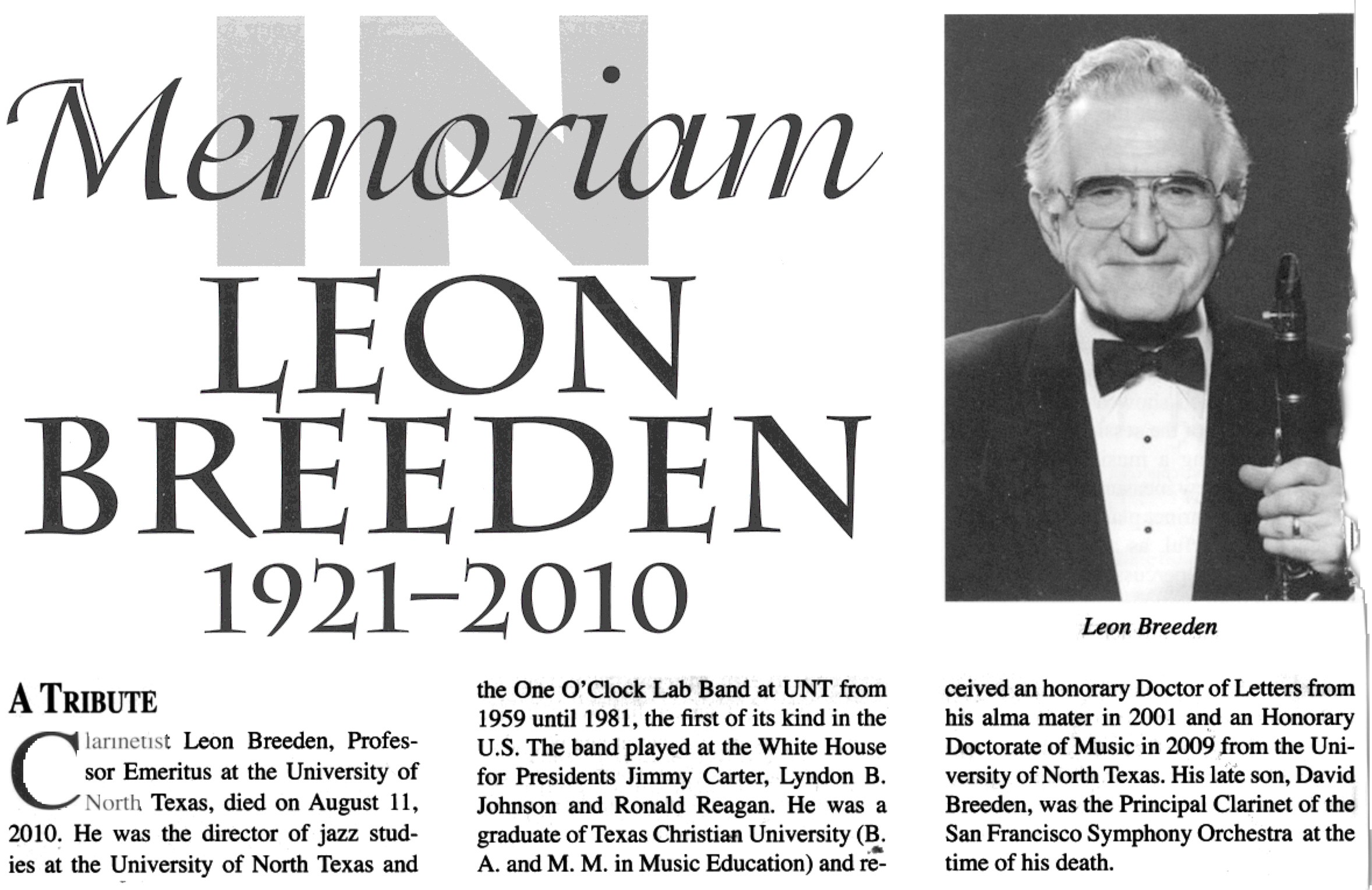
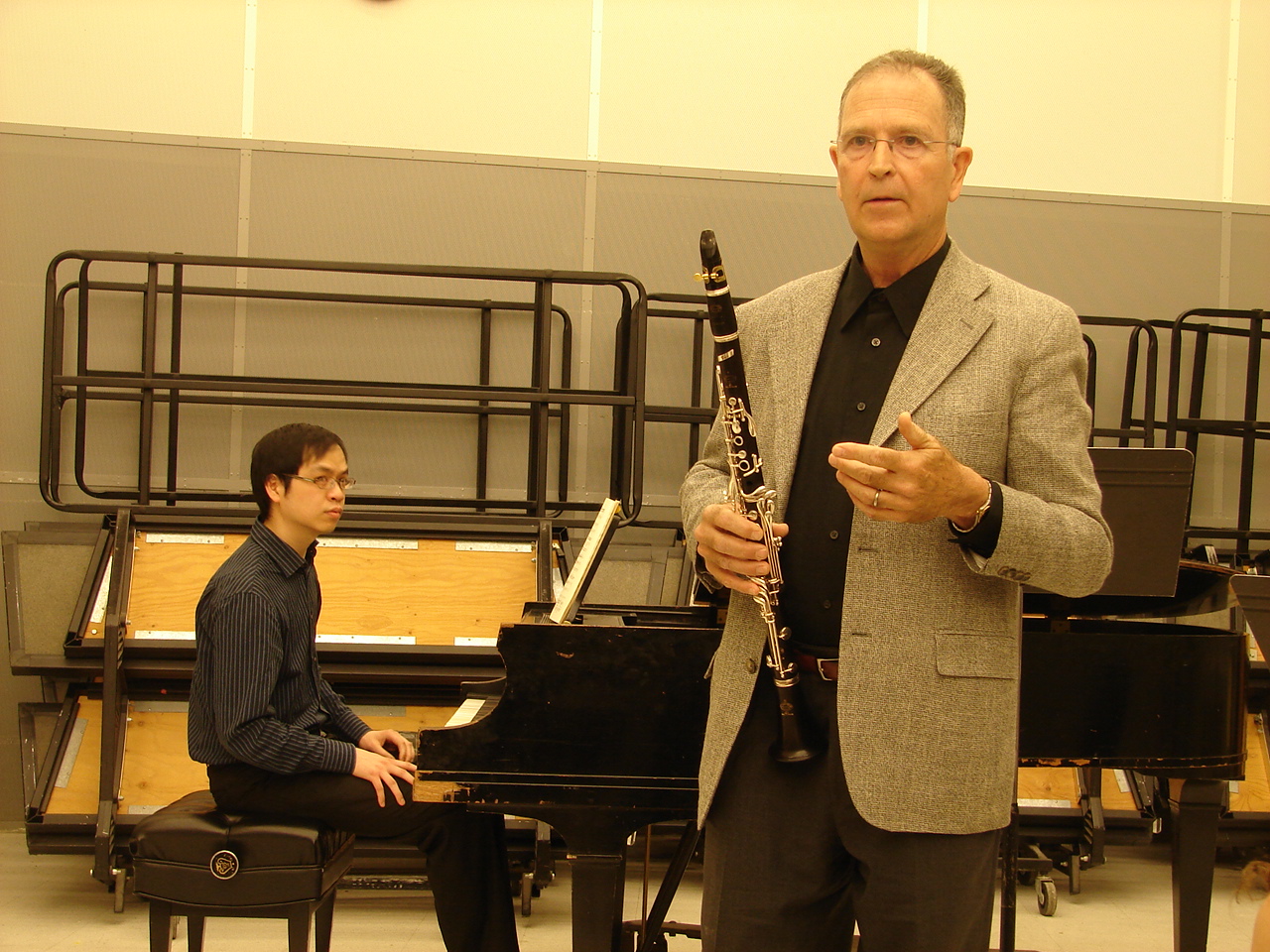
21 July 2010
David Etheridge - In Memoriam
Norman, Oklahoma
USA
For multitudes of Clarinetists around the world including students familiar with
the annual Oklahoma Clarinet Symposium at the University of Oklahoma and the
many International faculty who have participated in the last 35 years, his
passing has brought profound mourning after dying from Peritineal Cancer in such
a short period after discovery. Dr Etheridge has been a landmark icon for
his labor of love in this event every year as well as his teaching.
Information about David Etheridge is below which tells a remarkable history of
this great man.
David Ellis Etheridge
David Etheridge, 67, of Norman passed
away on July 21. He was born to Eileen
and Ellis Etheridge, September 11, 1942,
in Denver, Colorado.
David, a David Ross Boyd Distinguished
Professor, holds degrees from the
University of Colorado and the Eastman
School of Music, earning a Doctor of
Musical Arts in clarinet performance.
He had a zest for life and was very
devoted to his family and students at OU.
His other passions were practicing the
clarinet, cooking, sailing, skiing and
traveling.
Prior to his 35-year tenure at the Univ.
of Ok, he served on the faculty of the
Crane School of Music in Potsdam, New
York. He gave numerous recitals and
clinics across the United States and
Europe, and is a former member of the OK
City Philharmonic. He is the founder of
the OU Clarinet Symposium, which just
celebrated its 35th year. His most
recent publications include
Clarinet for Dummies, Mozart’s Clarinet
Concerto: The Performers View and
three instructional books .
He is survived by Cheryl, his wife of 47
years; mother Eileen Etheridge of
Denver, Co and father Ellis Etheridge of
Norman; son Scott Etheridge and
daughter-in-law Natalie, grandchildren
Bennett and Sydney of Atlanta; daughter
Suzanne Ouellette and son-in-law Thomas,
grandchildren Luc and Nina also from
Atlanta; sister Janet Klumas and husband
Larry of Calif.; Sister-in-law Charlene
Walker and husband Barry of Denver,
Colorado and niece Janet Lynn Robinson
and husband Mike of Seattle.
Dr. Etheridge will be buried in Denver,
Colorado following a 3:00 service on
July 28th at Olingers Crown Hill
Cemetary. A celebration of his life
will be held in Norman in September.
The family has requested that in lieu of
flowers, memorial contributions be made
to the the David Etheridge Clarinet
Scholarship, OU Foundation, 100
Timberdell Drive, Norman, OK 73019.
3 July 2010
Tsuneya Hurai - In Memoriam
Nishinomiya, Japan
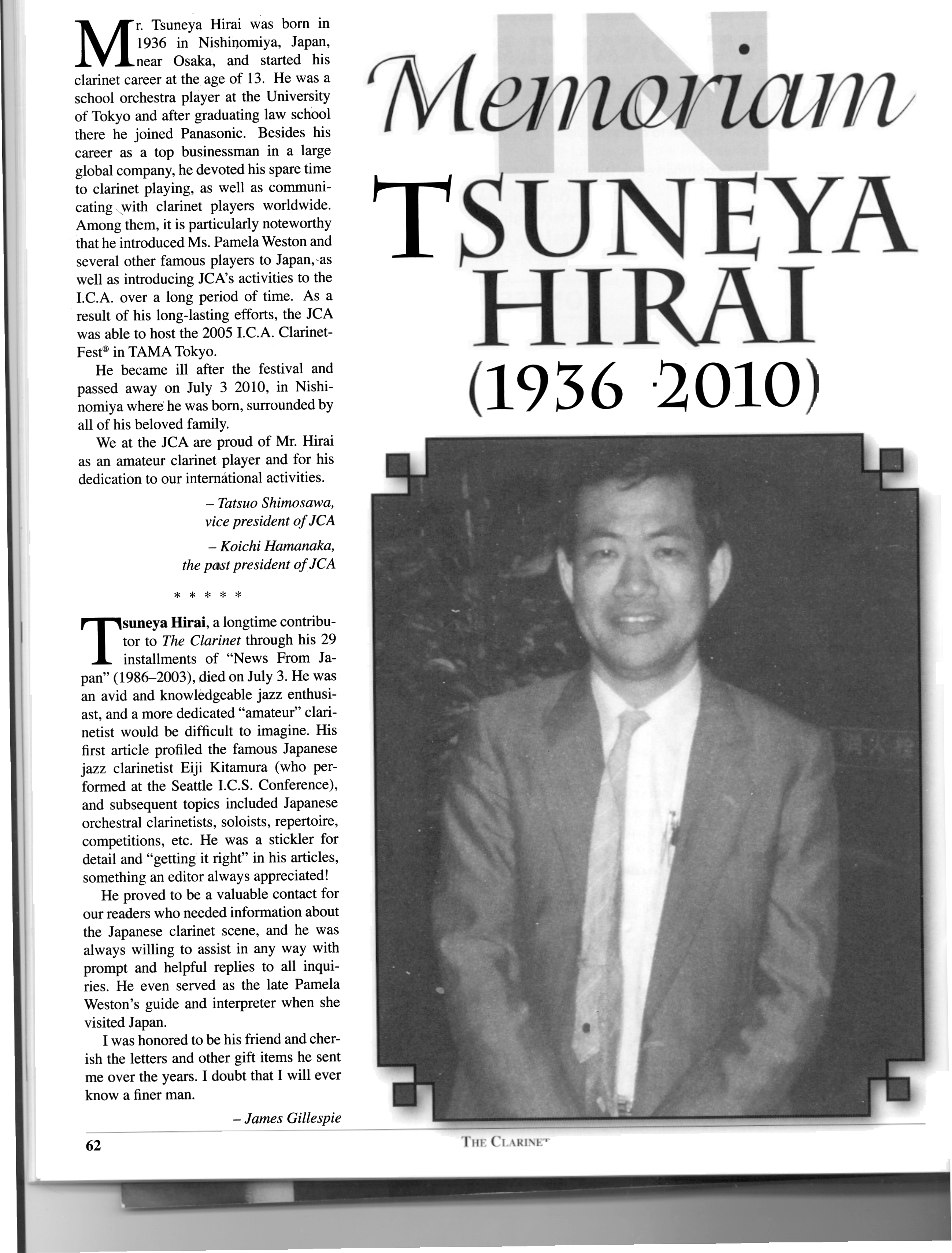
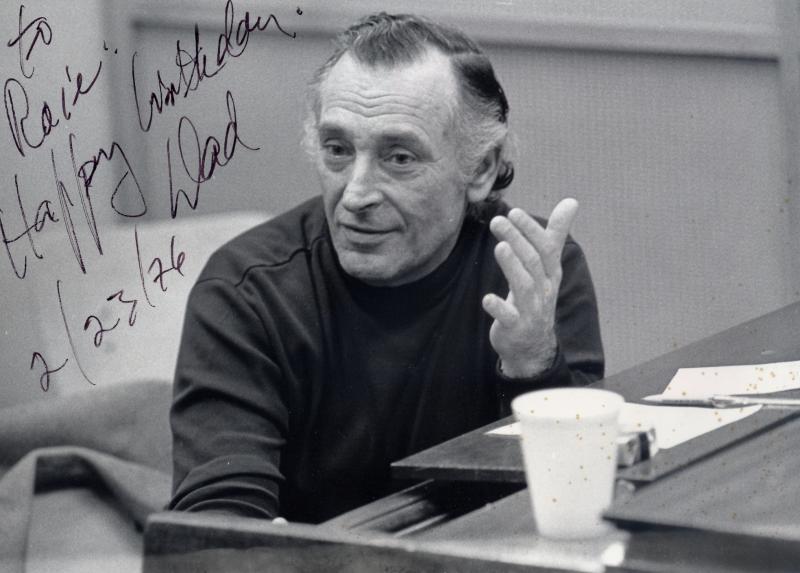
18 June 2010
Kalmen Opperman - In Memoriam
New York City USA
It is a shock to learn of the passing of this great Clarinet/Musician icon
during the Oklahoma Clarinet Symposium where on the second day the word reached
here. It was 1 December that he celebrated his 90th birthday with a great
tribute concert at Weill Recital Hall at Carnegie Hall with Richard
Stotzman presiding with many of his students and a Clarinet Ensemble conducted
by him performing for a sellout audience. Opperman's website hyperlinked
on his name above provides many details of his life history and legacy.
-
Kalmen Opperman, a master
clarinetist whose intensive teaching
methods helped mold some of the top
players of the last 50 years, died
on Friday in Manhattan. He was 90
The cause was
complications of congestive heart
failure, said his daughter, Roie
Opperman.
Mr. Opperman began his professional
career playing for ballet and
Broadway, but it was his relentless
pursuit of musical perfection and
highly personal teaching methods
that drew generations of students to
his studio.
“He was the elder statesman of the
clarinet,” said Stanley Drucker, who
was the longtime principal clarinet
of the New York Philharmonic until
his retirement last year.
In his quest for excellence, Mr.
Opperman became an expert in the
mechanics of the instrument and
often fabricated tuning barrels and
mouthpieces, but only for his
students. He wrote a series of
widely used technical studies and
the first authoritative guide to
clarinet reeds.
Perhaps his best-known pupil is the
international soloist Richard
Stoltzman, who had just completed a
master’s degree at Yale in 1967 when
he sought out Mr. Opperman for
instruction on reeds — the
two-and-a-half-inch-long pieces of
cane that are the obsession of most
players, a passionate fraternity of
tinkerers.
“I came to him with a sense of
entitlement, to take my place in the
music establishment,” Mr. Stoltzman
said with a laugh in an interview.
“He had me play a little. Then he
said, ‘Yeah, well, you don’t really
know where the holes are on the
clarinet yet.’ It was then that I
realized I would be a lifelong
student.”
Mr. Opperman was single-minded about
extracting the most from those he
taught. To that end, Mr. Stoltzman
said, he composed wry epigrams and
taped them to the walls of his
studio, which gradually expanded to
fill much of his apartment on West
67th Street in Manhattan. Among them
were, “Everyone discovers their own
way of destroying themselves, and
some people choose the clarinet.”
Larry Guy, a symphonic player,
teacher and author of books on reeds
and embouchure development — the
taut formation of the lips around
the mouthpiece and reed — was
already an established player when
he went to Mr. Opperman to correct
problems with his right hand.
Instead, Mr. Opperman identified
embouchure problems. Over three
years, Mr. Guy’s embouchure was
restored, and the hand problem
vanished.
“People went to him to clean out all
the clutter and the dust in their
playing,” Mr. Guy said. “He saw
things that other people didn’t see.
And he had great ears. This made him
a great diagnostician.”
Kalmen Opperman was born on Dec. 8,
1919, on the Lower East Side of
Manhattan, and grew up in Spring
Valley, N.Y., attending high school
there. His parents, Hyman and Rose,
were immigrants from Austria and
Poland. His father, an artist and
flutist, became his first music
teacher. As a teenager, Mr. Opperman
studied with Simeon Bellison, the
principal clarinetist of the
Philharmonic from 1923 to 1948.
From 1939 to 1943 he studied with
Ralph McLane, a revered player and
teacher who later became the
principal clarinetist of the
Philadelphia Orchestra. Through
McLane, Mr. Opperman grew to
exemplify what is known as the
French school, with lineage that
dates to the Paris Conservatory in
the late 18th century.
In 1938, Mr. Opperman successfully
auditioned for the West Point Band ,
where he played for three years,
ultimately serving seven years with
Army bands.
His Broadway career followed,
including nearly two dozen shows as
principal clarinet, the last being
the original production of “La Cage
Aux Folles” in 1983. He was also
principal clarinet for Ballet
Theater (later renamed American
Ballet Theater) and for the American
tour of the Ballet de Paris. He
taught and lectured widely, at
symposiums and universities around
the country.
Mr. Opperman was married three times
and divorced twice. After an early
marriage, he wed the former Prudence
Ward. Their children, Roie Opperman,
of Manhattan, and Charles Opperman,
of Chappaqua, N.Y., survive him.
Also surviving are his wife, the
former Louise Cozze, and his
brothers, George, of South Bend,
Ind., and Melvin, of Orange County,
Calif.
Opperman students often found that
lessons meant to last an hour could
go on for four. Mr. Stoltzman
recalled spending at least a week in
the Opperman apartment some years
ago, rising early for “a farmer’s
breakfast” and then beginning the
day’s instruction.
“He would deconstruct you,” he said.
“He would expose your false
attitudes about things. But at the
end, he would restore you to a whole
and make you feel that it was all
still possible.”
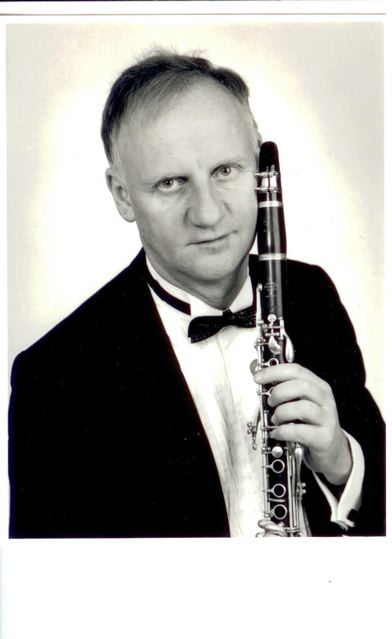
9 February 2010
Kjell-Inge
Stevensson - Acclaimed Swedish Soloist -
In Memoriam
Stockholm, Sweden
Kjell-Inge was born in Säffle in Sweden 1950 . He received his first
education at Music College of Ingesund . He continued his studies
with prof Nils Otteryd at Royal College of Music in Stockholm and at
only the age of 20 years he made his debut playing the Carl Nielsen's
clarinet concerto . He recorded this piece later with Herbert
Blomstedt and this recording is considered to be one of the prime.
1971 he won the Principal clarinet position in the Swedish Radio
Orchestra a position he has hold ever since
He continued his studies for Prof Guy Deplus and Prof. Walter
Boeykens. He has taught clarinet and chamber music at the Royal
College of music since 1977 and he holds the Professor of Clarinet
He has twice received the
Swedish Grammy award and also several
awards for his work in performing contemporary music.
He has served as guest
professor at Michigan State University in 1995
and also enjoyed a career in conducting. He formed the contemporary
ensemble Futurum which he travelled worldwide.
Kjell-Inge also served as jury
member at several times at
International competitions
He was awarded the Swedish
composers Interpret price 1997 and was
featured in Pamela Weston' s Clarinet Virtuosi of Today
He was co-host with Stefan Harg for the ICA's Clarinet Fest in 2002
He is featured on many CD such as Carl Nielsen Clarinet Concerto with
DRSNO and Blomsted . CD Virtuoso Clarinet with Eva Knardahl solo
pieces and sonatas. New music with Harry Spanjaard and Rebellious
Clarinettists with Stefan Harg and Crusell Sinfonia Concertante with
the SRSO and Kamu and several others . He also can be heard on the
Swedish Radio Orchestras CD with especially the Nielsens' symphony
5 / Salonen .
He was survived by his wife, 3
children and 3 grandchildren
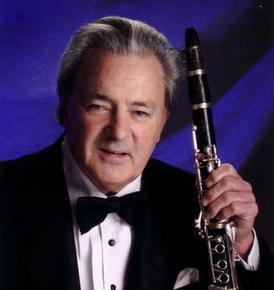
10 January 2010
Dick Johnson
- Jazz Clarinetist - In Memoriam
Boston,
Massachusetts USA
Dick Johnson, perhaps best known for his long stint as
frontman for the Artie Shaw Orchestra, died in the
Boston area on Sunday, January 10. Johnson died at Beth
Israel Deaconess Medical Center in Boston after a brief
illness, according to the Conley Funeral Home. He was 84
years old.
Johnson was born December 1, 1925 and grew
up in the Brockton, Mass area as part of a musical
family. He got his professional start as a musician
during a stint with the U.S. Navy in 1944-1946. Johnson
served with the navy band on the USS Pasadena during
WWII. He often credited his stint in the Navy for
kicking off his career in jazz.
After the war, Johnson toured with the big bands of
Charlie Spivak and Buddy Morrow. Eventually, after
several years on the road, he settled in his hometown of
Brockton, Mass. It was there in Brockton where he and
close friend, Lou Colombo formed a jazz sextet. The
group lasted 10 years, but the friendship and musical
kinship lasted for the rest of his life. In addition,
Johnson formed his septet—Swing Shift—which was a staple
on the Boston music scene for many years. Like Herb
Pomeroy, Johnson managed a double career as a perfomer
and an educator, teaching jazz at nearby Berklee, where
he mentored many younger jazz musicians.
According to
the notes on Johnson’s album
Artie’s Choice, in 1980, Artie Shaw sent a message
to Dick Johnson's manager, and said: "You wanted to hear
what I think of Dick Johnson's clarinet playing. Okay.
At this time, he's the best I've ever heard. Bar nobody.
And you can quote me on that, anywhere, anytime!"
Shortly thereafter in 1983 he joined the Artie Shaw
Orchestra as its frontman, with Shaw himself retired at
least as a clarinetist. Shaw continued to appear with
the group and let Johnson act as his surrogate for the
next 20 years. Idiosyncratic until the end, Shaw
permitted few recordings by the group, but Johnson’s
reputation as a clarinetist grew from its live
performances. The group disbanded in 2006 a few years
shortly after Shaw’s death.
Over the years Johnson performed with Dave McKenna,
Charlie Parker, Dizzy Gillespie, Frank Sinatra, Tony
Bennett and Buddy Rich. He recorded as a both a leader
and a sideman on the Mercury, Emarcy, Riverside, and
Concord Jazz labels. His latest CD was
Star Dust and Beyond: A Tribute to Artie Shaw for
the Crazy Scott label in 2006.
Johnson was an important part of the local Boston
jazz and music community. In 1999, Brockton declared May
1 to be “Dick Johnson Day.” Johnson spent the day
meeting students and later performed with school band
members at Brockton High.
Johnson is survived by family members including his wife
of 59 years, Rose Johnson of Brockton, his son, Gary
Johnson, and his daughter, Pamela Sargent, wife of noted
jazz guitarist Gray Sargent.
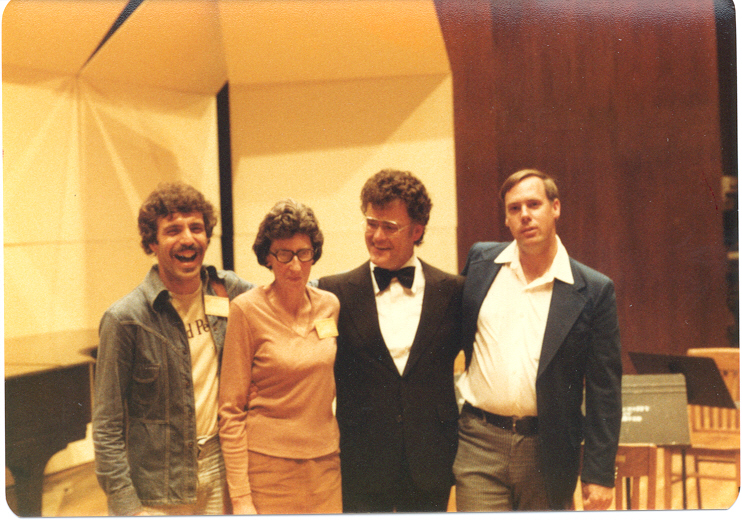
Eddie
Daniels, Pamela Weston, Karl Leister, and Mike Getzin from International
Clarinet Congress at University of Denver 1979
22 September 2009
Pamela
Weston - In Memoriam
London, United Kingdom
It is with
sadness that we note the passing of Pamela
Weston, one of the world's foremost
researchers and writers on the clarinet.
Weston is well-known for her excellent books
about clarinetists:
Clarinet
Virtuosi of the Past (1971),
More
Clarinet Virtuosi of the Past (1977),
Clarinet Virtuosi of Today (1989),
Yesterday's Clarinetists: A Sequel
(2002),
and
Heroes and Heroines of Clarinettistry
(2008). She wrote numerous articles for
journals and magazines, each one beautifully
written and a joy to read. Weston combined a
talent for writing with a dedication to
research, creating a collection of writings
about the clarinet and its players which
will be valued by the clarinet world for
many years to come. She is a true "Heroine
of Clarinettistry."
A letter written by Pamela Weston before her
death by assisted suicide, and explaining
her decision, was published in the UK
Times
Online and can be found
here.
Another article has been posted to the
"Action for M.E." website, and there is also
a
Clarinet BBoard thread going about
Pamela Weston. Most of her books can be
purchased through
Van Cott Information Services, Inc.
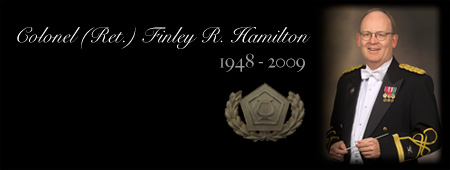
14 April 2009
J Finley
Hamilton - In Memoriam
Retired
Former Commander of The United States
Army Field Band
Ellicott City, Maryland USA
| |
|
Finley Ray Hamilton, Colonel (Ret.), United States Army, died of
cancer on Tuesday, April 14, 2009 at the age of 61 at his home in
Ellicott City, Maryland. His wife, Kathy, was with him throughout
his long illness.
Finley was born on January 21, 1948 in Richmond, Kentucky to Charles
and Nancy Hamilton. He attended Eastern Kentucky University’s Model
School and later Madison High School. He graduated from Eastern
Kentucky University with a Bachelor of Science degree in Music in
1970 and a Master’s degree in Music in 1975. Throughout his
education, he was an active member of the music fraternity Phi Mu
Alpha, and marked himself as a career musician early on.
I
n 1971, Colonel Hamilton was commissioned as an officer in the
United States Army through Eastern Kentucky University’s Reserve
Officers’ Training Corps. He would go on to have an illustrious
35-year career in the Army Bands Program, commanding the Army Ground
Forces Band at Ft. McPherson, Georgia, the U.S. Army Europe Band and
Chorus in Heidelberg, Germany, and The U.S. Army Field Band,
Washington, D.C.
Colonel Hamilton was a graduate of the Army’s Adjutant General’s
Officer Basic and Advanced Courses and the Command and General Staff
College. His decorations included the Legion of Merit, the
Meritorious Service Medal, the Armed Forces Reserve Medal, and the
Overseas Service Ribbon. He was given the Adjutant General’s Corps
Regimental Association’s highest award for service to the regiment,
the Horatio Gates Medal in Gold.
Colonel Hamilton was a member of the prestigious American
Bandmasters Association, the World Association for Symphonic Bands
and Ensembles, and the Texas Bandmasters Association. He was
President of the National Band Association at the time of his
passing. Eastern Kentucky University awarded him its honorary Doctor
of Arts degree in 2003 in recognition of his lifetime of service to
music, music education, and the university. He was also inducted
into the university’s Hall of Fame, and into the Honorable Order of
Kentucky Colonels.
Throughout his career, Colonel Hamilton remained active as a guest
conductor and clinician, conducting numerous state and national
music festivals and conventions, as well as the Cincinnati Pops
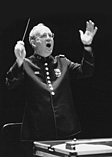 Orchestra,
the Boston Pops Orchestra, and the Detroit Symphony. He was a fine
representative of the United States Army and of the music community.
People close to him knew him for his old-fashioned, Middle American
sensibilities, his passion for excellence in music, his cheerful
pursuit of golf, and his appreciation of a good joke. His Soldiers
knew him as an honest, even-handed commander. Orchestra,
the Boston Pops Orchestra, and the Detroit Symphony. He was a fine
representative of the United States Army and of the music community.
People close to him knew him for his old-fashioned, Middle American
sensibilities, his passion for excellence in music, his cheerful
pursuit of golf, and his appreciation of a good joke. His Soldiers
knew him as an honest, even-handed commander.
Colonel Hamilton
is survived by his wife Kathy, his stepson José, and his sister
Rebecca Hamilton Brown of Ormond Beach, Florida. He is preceded in
death by his parents and his brother Benny.
Visitation for Colonel Hamilton will be held
at:
Slack Funeral Home
(directions)
3871 Old Columbia Pike
Ellicott City, MD
1600 to 1800
Sunday, April 19
Services will be held at:
Argonne Hills Chapel Center
(directions)
Bldg. 7100
Rockenbach Rd & Grandea Ave.
Ft. George G. Meade, Maryland
1000
Monday, April 20
Burial will be in:
Arlington National Cemetery
(directions)
1345 (following the services at Ft. Meade)
Those attending the interment should be at the Arlington National
Cemetery Administration Building between 1300-1315.
The family asks that remembrances of Colonel
Hamilton be sent in the form of donations to the Colonel Finley
Hamilton Music Scholarship Fund. Please send donations to Eastern
Kentucky University, Development Office, 521 Lancaster Avenue, CPO
10A, Richmond, KY 40475. Annotate the memo line of checks with: COL
Finley Hamilton Music Scholarship Fund. |
 |
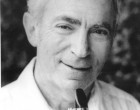
12 March 2009
Kalman Bloch
- In Memoriam
Los Angeles, California USA
Kalman Bloch
- Clarinetist for Los Angeles Philharmonic
Kalman Bloch, 95, principal clarinetist for the Los Angeles Philharmonic for
nearly 45 years, died March 12 at his home in Los Angeles, according to his
daughter, Michele Zukovsky, who is now one of the orchestra's co-principal
clarinetists.
Bloch was born in New York on May 30, 1913, and attended Columbia College. He
studied clarinet with Simeon Bellison, a legendary figure with the New York
Philharmonic.
When Bloch was having trouble finding work during the Depression, Bellison
encouraged him to send out resumes to 100 orchestras around the country.
According to Zukovsky, the only one to respond was conductor Otto Klemperer, who
was leading the Los Angeles Philharmonic.
Bloch traveled to L.A. and auditioned privately for Klemperer before playing for
the full orchestra hiring committee. He immediately got the job.
Bloch was principal first clarinetist from 1937 until his retirement in 1981.
For many of those years, he played alongside his daughter.
Albert Goldberg, then the Times' music critic, wrote that Bloch's playing of
Mozart's Clarinet Concerto on a program with the suite from Anton Berg's "Lulu"
and Schumann's Fourth Symphony, with Georg Solti conducting the Los Angeles
Philharmonic, was one of the highlights of the 1960 musical season.
Bloch also performed with studio orchestras on several film soundtracks,
including "Sunset Boulevard," "For Whom the Bell Tolls" and "North by
Northwest."
7 February 2009
Jacques
Lancelot - In Memoriam
Paris, France
A great loss for the clarinet world. passed
away on aged 88
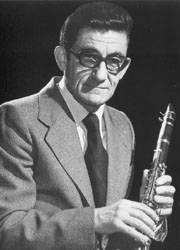
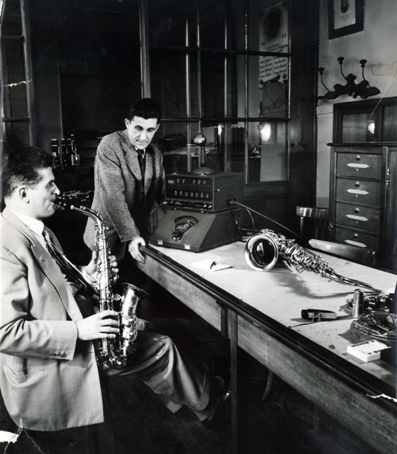
Atelier Buffet Crampon - Jacques
Lancelot (clarinet test player) accompanied by
Daniel Defayet (saxophone test player)
Having been a test player for Buffet Crampon for 46
years (1953-1999), Jacques Lancelot has been an
important figure for our company and for the world
of the clarinet.
Being an international soloist and teacher, Jacques
Lancelot is considered around the world being one of
the most authentic representatives of the French
clarinet school.
Being a student of Auguste Périer at the Paris
Conservatoire, he obtains his first prize in 1939
and continues his studies in the chamber music class
of Fernand Oubradous. He is appointed professor at
the Conservatoire National Supérieur de Musique de
Lyon at its foundation. He is a teacher at the
Académie Internationale de Nice from 1960 to 1975
and member of the jury of the Paris Conservatoire
and of many international competitions. His master
classes have been particularly appreciated in Japan,
where he formed a large number of musicians. Besides
being solo clarinetist of the Concerts Lamoureux and
the Orchestre de la Garde Républicaine, he was also
a member of the French Wind Quintet.
Thanks to his numerous recordings, he left us a rich
heritage, in particular with his world premiere
performance of Jean Françaix’ ‘Concerto’, for which
he obtained the Grand Prix du Disque in 1971.
The funeral will take place on Monday
16th February, 2.30 PM at
Eglise St Roch - 296 rue St Honoré 75001 Paris (Métro
Tuileries)
The burial will take place at 4.30pm in the
Montparnasse cemetery.
Discover his full biography at
/en/artists.php?mode=artistPresentation&aid=126
To be (re)discovered also, the following video made
in 1971:
http://www.youtube.com/watch?v=wTpkvQ4TdZI
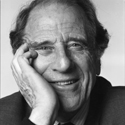
1 February 2009
Lukas Foss, Composer, Conductor, Pianist -
In Memoriam
New York City USA
| |
|
|
 |
 |
I
If it had music inside, Lukas Foss – who has
died in New York aged 86 – normally felt at
home. Foss was a composer, pianist and
conductor, but perhaps more significantly a
proselytiser for an extreme pluralism that,
although carried out with utmost integrity,
often led to controversy and – some might
say – an uneven legacy.
Foss was born in Berlin and came to the US
in 1937 with his Jewish family to escape an
uncertain future in Europe. If a young
composer/conductor influenced by Aaron
Copland and then becoming Serge
Koussevitzky’s conducting assistant at
Tanglewood sounds familiar, then Foss’s
career did orbit a parallel universe to that
of his friend Leonard Bernstein. William
Bolcom described Foss’s music as being more
“disciplined” than Bernstein’s, but then
Foss didn’t want the whole world to love him
and, anyway, didn’t have the sort of
personality that could have crossed into the
mainstream.
Instead
Foss listened hard to what was developing
around him, and poured his many discoveries
into his own music. Beginning as a neo-Stravinskian
classicist with an interest in Bartók, with
added Coplandesque spice (as his Piano
Concerto No 1 testifies), Foss later fell
under the spell of John Cage and cultivated
an interest in indeterminacy and
electronics; as minimalism became hip, Foss
wasn’t far behind and his pieces often
referred to jazz and rock. When Bernstein
premiered his Time Cycle in 1961,
Foss’s free improvisation group was invited
to link the movements together; when
Rostropovich played Foss’s Cello Concerto in
1967, he was obliged to engage with
aleatoric elements and electronics.
As a performer Foss
was just as bold. He led the Buffalo
Philharmonic from 1963 to 1970 and his
wildly radical programmes provoked bruising
orchestral politics, but genuinely
revelatory concerts: Foss was alone in
programming Julius Eastman, the militant
black gay composer whose works bristled with
volatile anger and required classical
musicians to improvise. He also had a career
as a concert pianist, recording Bernstein’s
Age of Anxiety Symphony twice with
its composer. Bernstein’s recordings of
Time Cycle, Phorion and Song of Songs
were reissued on Sony in 1997, and in 2003
Naxos released his complete piano music. His
impractical requirements and sometimes
overstacked concepts mean his compositions
will forever be a rarity live, but let’s
celebrate Foss as a composer who always
dealt with the actualité: in 1997 he said
“The funny thing is that after all these
works, I still don’t have a recipe for
composing.” But he never stopped cooking.
Philip Clark |
 |
 |
 |
 |
 |

24 November 2008
Mitchell Lurie -
In Memoriam
Los Angeles, California USA
One of the most revered American Clarinetists passed away on this date. Mr
Lurie has been respected as one of the leading players and teachers as he has
been in several Symphonies including Pittsburgh and Chicago Symphonies, and a
leading Hollywood Studio musician being heard in several films over the last 35
years. He was a Professor at major Universities in California including
the University of Southern California (USC) and the University of California at
Los Angeles (UCLA). He is a past student of Daniel Bonade when he was a
student at the Curtis Institute in Philadelphia. Many of his past students
have been successful as performers and teachers, and Mr Lurie has always been
proactive at Festivals doing Master Classes on the International scale. In
addition to all these activities he has embarked on several projects including
developing his own brand of Clarinet Reeds that are used worldwide, and recently
premiered the issue of the Tyrone Student Clarinets.
Played principal clarinet under Fritz Reiner in Pittsburgh and
Chicago Symphonies,
soloist with Los Angeles Symphony, and the premiere clarinetist
in the motion picture studios in Los Angeles for over 25 years. Many
outstanding recordings, well-beloved teacher at University of Southern
California, many outstanding students who are now playing and teaching
all over the country. Also produced Mitchell Lurie clarinet mouthpieces,
ligature, and reeds.
Certainly one of the very finest US players of the 20th century. Pablo
Casals called him "the ideal clarinetist".
In respectful commemoration of Mr Lurie, A group of his
students, his son Alan, and Larry Guy are involved in a project to make available a CD of his
greatest performances, and Boston Records is interested in producing it. At the moment, we are taking
donations to make this CD a reality, and I have been elected secretary of the incoming donations.
If you or any of your subscribers
would like to make a donation to this tribute CD, you can make a check payable
to
Mitchell Lurie Tribute Fund
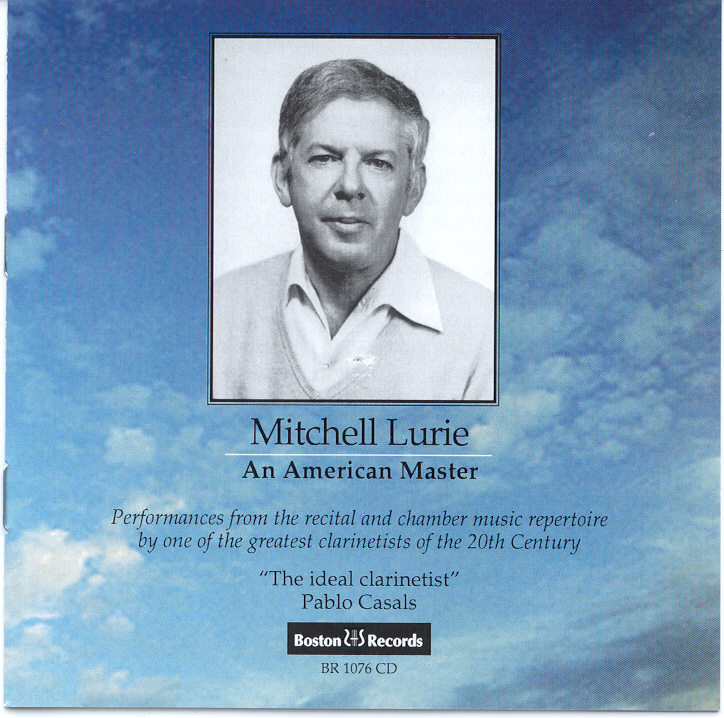
and mail it to me (see address below). I have established a bank account whose
sole purpose is to receive these donations. When the funds have been
accumulated,
we will use them to pay the costs of the CD, and if there is any money left
over, it will go
to the Mitchell Lurie Scholarship Fund at USC.
Larry Guy
36 Hudson Avenue
Stony Point, NY 10980
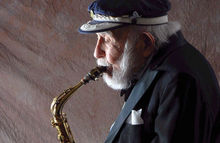
4 October 2008
Alfred J.
Gallodoro - In Memoriam - Clarinetist, Bass Clarinetist, Jazz Saxophonist
Oenienta, New York USA
Legendary Saxophonist's Career Spanned Eight Decades
Obituary by:
Peter Westbrook
 Legendary saxophonist and clarinetist Alfred J. Gallodoro, featured
soloist with the Paul Whiteman Orchestra from 1936 to 1940, passed
away October 4th at the age of 95. During a professional career
spanning more than eight decades, Gallodoro worked in virtually
every musical environment, from vaudeville houses, speakeasies, and
night clubs to symphonies, Carnegie Hall, and international jazz
festivals. He claimed to be one of the world's longest continually
active performing musicians. He was referred to by Jimmy Dorsey as
". . . the greatest saxophone player that ever lived," and received
similar plaudits from the likes of Paquito D'Rivera, Benny Golson,
Buddy DeFranco and Eddie Daniels.
Legendary saxophonist and clarinetist Alfred J. Gallodoro, featured
soloist with the Paul Whiteman Orchestra from 1936 to 1940, passed
away October 4th at the age of 95. During a professional career
spanning more than eight decades, Gallodoro worked in virtually
every musical environment, from vaudeville houses, speakeasies, and
night clubs to symphonies, Carnegie Hall, and international jazz
festivals. He claimed to be one of the world's longest continually
active performing musicians. He was referred to by Jimmy Dorsey as
". . . the greatest saxophone player that ever lived," and received
similar plaudits from the likes of Paquito D'Rivera, Benny Golson,
Buddy DeFranco and Eddie Daniels.
Greatly admired for his musicianship and versatility, Gallodoro
performed classical music as well as jazz under many famed
conductors, including Isham Jones, Arturo Toscanini, Leopold
Stokowski, Alfredo Antonini, Leonard Bernstein, Andre Kostelanetz.,
Johnny Green, Tutti Camarata, Arthur Fiedler, Percy Faith, Skitch
Henderson and Dr. Frank Black. Among the greats with whom he worked
were George Gershwin, Victor Borge, Dina Shore, Sid Caesar, Raphael
Mendez, Les Paul, Bob Hope, Edgar Bergen, Duke Ellington, Tommy
Dorsey, Mario Lanza, Frank Sinatra and Milton Berle. He appeared on
countless movie and cartoon soundtracks. He also had music composed
for him, most notably the Gallodoro Serenade written in 1958
by composer Ferde Grofè.
Gallodoro was featured in 2002 on CBS' Sunday Morning, and
was the topic of a PBS documentary, the Al Gallodoro Story.
He received an Honorary Doctoral Degree from Hartwick College in
recognition of a lifetime of extraordinary achievements in music.
Among these, he held the the world record for the most performances
of the clarinet slide in Gershwins Rhapsody in Blue which he
claimed to have played over 10,000 times.
Born June 20, 1913, Gallodoro was raised in Birmingham, AL. His
first job was in 1926, a one week booking doing three vaudeville
shows a day at Birmingham's Lyric Theatre, with the Romeo and his
Juliet's band of the Romeo brothers, whose father would pick Al
up from school. He was somehow able to join the union even though he
was at least two years below the required minimum age. He continued
to work in Alabama, and later in New Orleans where his parents
relocated in 1927. At age 15 he became the first chair alto
sax/clarinet in the Orpheum Theater house orchestra in New
Orleans, accompanying well known vaudeville acts such as Bob Hope,
Edgar Bergen, and Milton Berle. After the last show he would play
from 11:30pm to 5 am at a night club called the Frolics, a routine
he maintained until July 1933.
Moving to New York, Al freelanced for some time, including work
with Isham Jones' orchestra as a sax soloist. Then, in the spring of
1936, he joined the Paul Whiteman Orchestra as first chair saxophone
and clarinet and featured soloist. Playing clarinet, bass clarinet
and alto sax earned him the nickname "Triple Threat." The orchestra
disbanded in 1940, but in 1947 Whiteman became the Musical Director
for WJZ Radio, later ABC Radio. Whiteman arranged for
Al to join the staff as a soloist. Gallodoro stayed with WJZ until
1967, performing up to four live solos per week; over twenty
arrangements were written specially for him. It was his belief that
he played more live solos on the air than any other musician.
Gallodoro also joined the NBC Symphony in June 1942 where he
played bass clarinet under Toscanini and Stokowski, as well as Dr.
Frank Black.
From 1967 Al freelanced in New York, making countless records on
various labels and playing for dozens of radio and TV programs. In
1981 he moved to Oneonta, NY. Until very recently he was still
teaching and playing with local groups.
Praise for Galladoro came from all sides. Benny Golson wrote:
"Amazing! The world should know Al Gallodoro, he is a hero in my
eyes and in the eyes of the many others who know him. This guy was
unreal, he must have been from Mars!"
Paquito D'Rivera, who was inspired as a boy by Al's Saxophone
Contrasts album, sent this message: "With deep, very deep
admiration, your NUMBER ONE FAN!"
Buddy DeFranco wrote, in The Clarinet of 12/99 ""Art
Tatum, Charlie Parker, Heifetz, Perlman and Gallodoro are unequaled
and may be for years to come."
The following tribute is from Saxophone Journal, March
2001: "Everywhere he performs or works, the living legend continues.
And although legends tend to grow in size, once you hear this artist
the stories of his greatness are, indeed understated . . . In all
aspects of saxophone performance whether it be tonguing,
articulation, interpretation or musicality, Al Gallodoro is the
consummate master . . . His thoughts for musical improvisations are
as prolific as his technical wizardry is prodigious."
More information: www.algallodoro.com
|
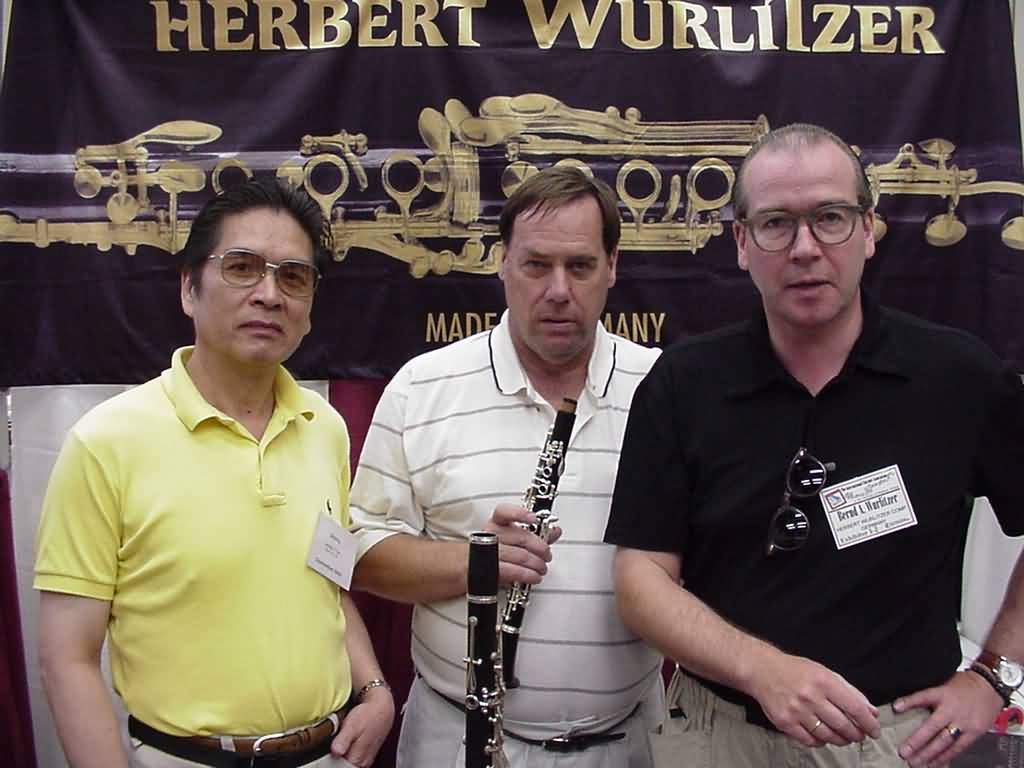
Jimmy Yan,
Mike Getzin, and Bernd Wurlitzer
16 August 2008
Jimmy Yan - In
Memoriam
Bronxville, New York USA
Jimmy Yan, one of the most renowned artist Clarinet repair artisans, passed away
on this date from advanced Cancer after a long illness. He is remembered for
many years as the most sought after Clarinet repair/maintenance craftsman
serving the most important players in New York, including members of the New
York Philharmonic, the Metropolitan Opera Orchestra, and many major soloists,
teachers and students from the New York area. While in China, he was Clarinet
Professor at the University of Shanghai, and upon coming to the United States in
1975, worked as a Clarinet technician for Fred Weiner at Wiener Music before
setting up his own specialty shop in the mid-eighties. During his time in
New York, he intensively studied Mouthpiece design and facing with Everett
Matson. He is an immigrant from
China, where he came to the United States to escape the tyranny from that time
there.
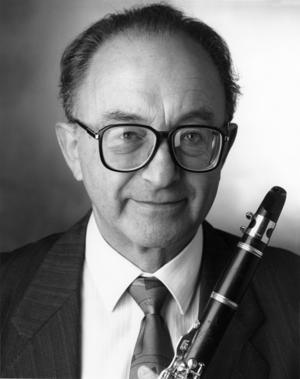
15 June 2008
Gabor Reeves - In
Memoriam
Sydney, Australia
AS ONE of Australia's leading classical musicians Gabor Reeves
was a serious performer and academic, of course. Unusually
perhaps, he was also a burlesque showman. He was a clarinetist
with symphony orchestras around Australia and overseas but his
desire to entertain led him to create a couple of zany
characters to complement the serious side of his work.
"Eric Lant" was used when he wanted to perform incognito. The
other, a more flamboyant one, was "Clare Nit", who made "her"
debut in Adelaide many years ago, singing Danny Boy in
falsetto. She went on to perform in Sydney on the clarinet as
well. Her favorite piece was Immer Kleiner, where she
gradually removed parts of her clarinet until all that was left
was the mouthpiece on which she squeaked the theme, then packed
it into the case, and walked off the stage.
Gabor Revesz was born in Budapest of Jewish parents, Oszkar
Revesz, the managing director of a large porcelain factory and
an accomplished amateur violinist, and his wife, Mitszu Kovesi.
The family converted to Catholicism to avoid persecution during
World War II but still suffered.
After surviving the bombing of their apartment block, Gabor was
interned by the pro-German, anti-Semitic Arrow Cross government.
In December 1944 he survived being shot by falling into the icy
waters of the Danube and playing dead. He and others had been
told to empty their pockets and descend to the edge, facing the
water. Then the shooting started.
"On the first shot the teacher cried out, then the boy on my
left," Reeves told his son in later years. "The third shot was
obviously quite accurate, as the boy never uttered a sound, just
slid into the water. I was the only one left standing so I was
prepared. When the sound came, I slid into the water."
After he had been given up for dead, he managed to stumble to a
shelter. The next day he made his way to safety in the house of
his school friend Tommy Tycho. Their association continued after
the war and he sponsored Tycho in 1950 to migrate to Australia.
Tycho became well-known here as a pianist, conductor and
arranger.
Revesz came to Australian in 1948, anglicised his surname to
Reeves and a few weeks later fell in love. He and Zsoska
Scheffer were married the following year. They had two sons, Ron
and Steve, who became musicians, but they were divorced after 25
years. In 1977 he married again, to Anthea Hamilton, and became
stepfather to Richard and Nicola.
In Australia, Reeves continued his clarinet studies and
supported himself playing jazz. He took his diploma from the
Sydney Conservatorium of Music and started a career in classical
music. In 1951 he became principal clarinet in Queensland, and
three years later, principal of the Sydney Symphony Orchestra
for six years.
In 1960 he went to London
freelancing. From time to time he played with the London Mozart
Players and he was also principal clarinet in the Bach Festival
Orchestra, conducted by Nadia Boulanger, and performed in the
Schubert Octet at a chamber music concert led by Yehudi Menuhin.
Reeves returned to Australia in 1963 and became principal
clarinet in the Victorian Symphony Orchestra. In 1964 the family
moved to Adelaide, where Reeves was lecturer at the Elder
Conservatorium and a member of the newly formed Adelaide Wind
Quintet. He performed extensively with the quintet throughout
Australia, the US, Canada, Britain, Europe and South-East Asia.
He also joined the renowned Bartok Quartet in a performance at
Adelaide Town Hall of Mozart's Clarinet Quintet.
After 10 years in Adelaide, Reeves returned to Sydney to found
the Sydney Wind Quintet. He was appointed professor and head of
the wind department, later head of performance studies, and
eventually acting director of the Conservatorium. During his 21
years in Sydney, he developed a close musical relationship with
the pianist Rachel Valler, with whom he gave many recitals. In
1982 and 1989, Reeves was also a visiting professor at Michigan
State University.
In 1988, he staged the Gabor Reeves Centenary Concert to
celebrate his 60th birthday and 40 years in Australia. For that
occasion he commissioned works for clarinet, double bass and
percussion, so that he could play them with his sons Steve
(double bass) and Ron (percussion).
Reeves had a great sense of humor and didn't mind poking fun at
himself (within his family he called himself "Garbage Leaves").
He was an inveterate punster. Once, driving past the Seymour
Centre in Sydney, he asked, "Why is it called the Seymour
Centre?" and answered straightaway, "Because you can't see more
left, you can't see more right, but you can Seymour Centre." His
wit showed in lyrics he wrote and performed, such as one about a
shower cap: "Always firm yet so elastic, you can trust it if
it's plastic." His sons played one of his songs at his funeral,
to the delight of all present.
In 1995 Reeves was awarded an AM for his services to music and
as an educator. He and Anthea returned to Adelaide, where he
continued to play chamber music and teach until late 1996, when
Parkinson's disease forced him to stop.
Although he and Zsoka Scheffer were divorced, they remained
close friends. Late in his life, when he was incapacitated by
the disease, Zsoka helped Anthea care for him.
Gabor Reeves is survived by Anthea, Zsoka, brother Janos,
sisters-in-law Maria and Diana,sons Steve and Ron, stepchildren
Nikki and Richard and their families.
Ros Dunlop and Rachel Valler

15 April 2008
Thomas Friedli - In Memoriam
Geneva, Switzerland
A tragic
Mountain Climbing
accident in Portugal has taken the life of one of Europe's great Clarinetists and Teachers,
and active supporter to the professional development of Clarinetists, especially
his role as President of the Clarinet Jury of the Geneva Clarinet Competition,
just recently held in Geneva. Information about his renowned career is indicated
below.
Thomas Friedli studied music in Berne, Lausanne and
also in Paris. In 1972, he was awarded the First Prize
for Clarinet and the Ernest Ansermet Prize at the
Geneva International Music Competition. This success
was followed by other prizes and distinctions.
From 1971 to 1986, Thomas Friedli played clarinet solo
for the Berne Symphonic Orchestra. He then took up the
same post for the Lausanne Chamber Orchestra. Since
1978, he has taught a virtuosity class at the Geneva
Conservatoire. He regularly gives master classes in
Sion, Biella and also in several European countries.
His long tours have taken him across Japan and
throughout South America, in particular Brazil. He has
performed with great success at the Lucerne, Gstaad,
Zurich, Echternach, Bratislava, Sao Paolo, Stresa,
Meiringen and Ibiza music festivals.
His interests cover a wide range: from unknown works of
the classical and romantic periods to contemporary
music.
He has created a large number of concertante partitions
of works by Swiss composers.
Thomas Friedli has recorded numerous discs for CLAVES.
He received the Golden Disc Award for his recording of
W.A. Mozart's Concerto for Clarinet. |
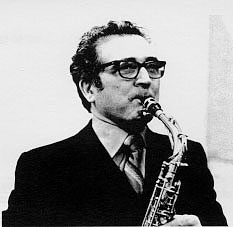
7 February 2008
| |
|
|
Vincent J. Abato -
In Memoriam
Melbourne, Florida
USA
|
|
|
|
Vincent
J. Abato, age 89, of Melbourne, FL and formerly of
Malverne, NY. Proud US Navy Veteran. Vincent
graduated from the Juilliard School of Music where
he also taught for many years. He played the
clarinet and saxophone and was an original member of
the Glenn Miller Band. He also played in the Tommy
Dorsey Band and at the Metropolitan Opera House for
many years. |
|

December 8, 2007 - In Memoriam
Karlheinz
Stockhausen, Influential Composer and Avant-Garde Guru, Dies at 79
Kuerten, Germany
Karlheinz Stockhausen, an original and
influential German composer who began his career as an inventor of new musical
systems and ended it making operas to express his spiritual vision of the
cosmos, died on Wednesday at his home in Kuerten-Kettenberg, Germany. He was
79.His death was announced on
Friday by the Stockhausen Foundation; no cause was disclosed.
Mr. Stockhausen had secured his place in
music history by the time he was 30. He had taken a leading part in the
development of electronic music, and his early instrumental compositions
similarly struck out in new directions, in terms of their formal abstraction,
rhythmic complexity and startling sound.
More recently, he made news for his public
reaction to the attack on the World Trade Center. Not widely known outside the
modern-music world in 2001, he became infamous for calling the attack “the
greatest work of art that is possible in the whole cosmos.” His comments drew
widespread outrage, and he apologized, saying that his allegorical remarks had
been misunderstood.
Mr. Stockhausen produced an astonishing
succession of compositions in the 1950s and early ’60s: highly abstract works
that were based on rigorous principles of ordering and combination but at the
same time were vivid, bold and engaging.
In “Song of the Youths” (1956), he used a
multichannel montage of electronic sound with a recorded singing voice to
create an image of Shadrach, Meshach and Abednego staying alive in
Nebuchadnezzar’s fiery furnace. In “Groups” (1957), he divided an orchestra
into three ensembles that often played in different tempos and called to one
another.
Such works answered the need felt in
postwar Europe for reconstruction and logic, the logic to forestall any
recurrence of war and genocide. They made Mr. Stockhausen a beacon to younger
composers. Along with a few other musicians of his generation, notably
Pierre Boulez and Luigi Nono, he had an enormous influence. Though
performances of his works were never plentiful, his music was promoted by
radio stations in Germany and abroad as well as by the record company Deutsche
Grammophon, and he gave lectures all over the world.
By the 1960s his influence had reached rock
musicians, and he was an international subject of acclaim and denigration.
The intellectual and physical excitement of
his earlier music diminished in the later 1960s, when he devoted himself
largely to performing semi-improvised music with a chosen group of performers.
The tone of his lectures and essays also changed. Earlier he had based his
thinking on psychoacoustics and the nature of musical time; now he presented
himself as the receiver of messages about a spiritual drama being played out
in the cosmos.
Between 1977 and 2002, he concentrated his
creative efforts on “Light,” a cycle of seven operas intended to bring that
cosmic drama to the human stage. The project was extravagantly egomaniacal.
Mr. Stockhausen devised the music, the scenario and the words for his operas,
and he made stipulations about sets, costumes and lighting. During the period
of “Light” and after, Mr. Stockhausen was venerated within his own circle of
performers and family members (often the same people) but largely ignored
outside it. His home at Kuerten, which he designed, became the center of a
publishing, recording and promoting enterprise removed from the wider world.
Formerly a star, he had turned into a guru.
Karlheinz Stockhausen was born on Aug. 22,
1928, near Cologne, the first child of Simon Stockhausen, a schoolteacher, and
his wife, Gertrud. His mother began suffering deep depressions when he was
still a boy and was committed to a mental hospital, where, according to Mr.
Stockhausen, she was “officially killed” in 1941. His father later volunteered
for the army and was killed in Hungary.
The young Mr. Stockhausen himself served as
an orderly to a military hospital during the last year of World War II, after
which he studied at the State Academy of Music in Cologne. He took composition
lessons from Frank Martin, but his training was as a music teacher. He also
played jazz in Cologne bars, directed an amateur operetta theater and, as he
later remembered, “prayed a lot.”
His ambitions changed in July 1951, when he
attended a summer music course at Darmstadt and heard a recording of
Olivier Messiaen’s piano piece “Mode of Values and Intensities,” which he
described as “incredible star music.” On his return to Cologne, he began
studying the music of Messiaen, writing his own similarly conceived work, “Crossplay,”
for piano, percussion and two wind instruments.
As “Crossplay” shows, he understood at once
how Messiaen’s single notes could be organized by applying Schoenberg’s serial
principle to every dimension of sound: pitch, duration, loudness and tone
color. A few formal rules would be set up, and the notes would fall into
patterns as of themselves. Here his admiration for Hermann Hesse joined with
his intense Roman Catholic faith to give him confidence in a kind of music
that would be new and pure, reflecting the unity of the divine creation.
He arrived in Paris in January 1952 and
stayed 14 months, during which he wrote two big orchestral scores;
“Counter-Points,” an exuberant ensemble piece with instrumental flourishes;
and the first four of a continuing series of piano pieces. He also composed
his first electronic piece. When he went back to Cologne, it was to assist in
the foundation of an electronic music studio, as well as to marry his student
sweetheart, Doris Andreae, with whom he had four children during the next
decade: Christel, Suja, Markus and Majella.
Between 1953 and 1955, he wrote more piano
pieces (influenced by a first meeting with
John Cage and with Cage’s regular pianist, David Tudor) and two electronic
studies. Then came works on a more public scale: “Song of the Youths” and
“Groups.” He was attracted by the idea that pitch, timbre, rhythm and even
musical form could all be understood as forms of vibration, and by the notion
of an entire musical work as a kind of photographic blowup of a single sound
or sequence of sounds.
The first performance of “Groups,” in 1958,
confirmed his dominant position within the European avant-garde. But he kept
moving on. His music became slower and more enveloping in the electronic
“Contacts” (1960) and in “Moments” for solo soprano, choir, brass, percussion
and electric organs (1964). At the same time, his Catholic piety began giving
way to a broader spirituality that embraced Eastern thought. He also fell in
love with the American visual artist Mary Bauermeister. He divorced his first
wife to marry her in 1967; they had two children, Simon and Julike.
His first visit to Japan, in 1966, was
crucial to his artistic development. He was impressed by traditional Japanese
culture and gained an awareness of himself as an artist in a global context.
In Tokyo he composed the electronic piece “Telemusic,” in which recordings of
music from around the world are made to intermingle. On his return to Cologne,
he produced “Anthems” (1967), an electronic composition based on national
anthems. For a few years after that, much of his work was devised for his own
live-electronic performing group.
Working with his chosen musicians, he
simplified his notation, until, in “From the Seven Days” (May 1968), he was
offering his players only a text on which to meditate in performance. He spoke
not of improvisation but of “intuitive music,” the idea being that his words
would guide the performers to a metaphysical connection with music beyond
themselves.
With “Mantra” for two pianos and
electronics (1970) he returned to precise notation and introduced a new style,
in which entire compositions were to be elaborated from basic melodies. The
method gave him the means to fill long stretches of time, and from then on his
major works were of full-evening length. They included “Starsound” for several
groups in a public park (1971) and“Inori” for orchestra (1974).
Once again, a turn in Mr. Stockhausen’s
music coincided with a new page in his emotional life. In 1974 the American
clarinetist Suzanne Stephens entered his entourage, and she remained his
companion to the end, joined from the early 1980s by the Dutch flutist
Kathinka Pasveer. These two, along with his son Markus, a trumpeter, and his
son Simon, on saxophone and synthesizer, gave him a new ensemble.
They also became the central performers of
“Light”: Markus, who shared his father’s striking good looks, as the hero
Michael; Ms. Stephens or Ms. Pasveer as the lover-mother figure, Eva; and
often a trombonist as Lucifer, the spirit of negation.
The first three “Light” operas were
introduced by La Scala, the next two by the Leipzig Opera; the remaining two
have not been staged. Mr. Stockhausen’s final project was “Sound,” a sequence
of compositions for the 24 hours of the day.
Mr. Stockhausen is survived by his
companions, his six children and several grandchildren.
Right from his early 20s he never doubted
that he was a great composer, and this conviction guided all his actions. It
made him authoritarian in his dealings with others, whether fellow musicians
or administrators. It pulled him through the creative challenges he set for
himself as a young man. But it left him an isolated figure at the end.

14 November 2007
In Memoriam - David Oppenheim, Clarinetist
and Dean of N.Y.U. Arts
New York City USA
Published: December 3,
2007
David Oppenheim, a
clarinetist at Tanglewood and a producer of classical
music records and television documentaries who became
the main architect of the Tisch School of the Arts at
New York University, died in New York on Nov. 14. He
was 85 and lived in Manhattan.
Taking charge of what
had been a collection of departments in offices and
classrooms scattered throughout Lower Manhattan, Mr.
Oppenheim transformed N.Y.U.’s arts programs into a
major institution offering programs taught by
professionals in photography, cinema, musical theater,
dramatic acting and writing.
Mr. Oppenheim was
dean of the N.Y.U. School of the Arts from 1969 to 1991,
and in 1985 he secured a donation of $7.5 million from
Laurence A. Tisch and his brother, Preston Robert
Tisch, billionaire businessmen who were then members of
the N.Y.U. board of trustees. With that donation, most
of the school’s programs were centralized in a 12-story
building at 721 Broadway as the Tisch School of the
Arts.
Mary Schmidt
Campbell, the current dean of the Tisch School, said
last week that under Mr. Oppenheim the school’s
enrollment increased to 3,000 from 600 and its budget to
about $50 million from $2 million. But far more than
growth mattered to Mr. Oppenheim, Ms. Campbell said.
“He made it clear
that this was not going to be an academic school of the
arts,” she said, “this was going to be a school where
working professionals teach” — among them the director
Martin Scorsese, the actress
Olympia Dukakis and the noted Broadway lighting
designer Jules Fisher. In the 1970s, in cooperation with
Leonard Bernstein, Mr. Oppenheim started the
school’s musical-theater writing program.
Mr. Oppenheim also
created what the school calls its studio system. “When
our undergraduates study acting, they do so at
independent professional studios outside of N.Y.U.,” Ms.
Campbell said, including the
Lee Strasberg Theater and Film Institute and the
Stella Adler Acting Studio. The school’s alumni include
Mr. Scorsese,
Spike Lee and
Oliver Stone. In 1970, New York State gave approval
for the school’s film studies program to grant doctoral
degrees, making it the first such program in the United
States.
“The miracle to me is
that the school was founded in 1965, and within five
years it was on the map,” Ms. Campell said. “And David
Oppenheim was the architect of that.”
It was music that
first attracted Mr. Oppenheim. Born in Detroit on April
13, 1922, he was a son of Louis and Julia Nurko
Oppenheim. His father owned a department store.
Mr. Oppenheim began
playing clarinet as a young boy. When he was 13, the
family moved to New York. For a year, he studied at
Juilliard; he then transferred to the Eastman School of
Music, from which he graduated in 1943. He served as an
anti-tank gunner in Germany during World War II.
After the war, he
received a scholarship to study at the Tanglewood Music
Festival in Massachusetts. There, over several summers,
he performed under famous conductors, including
Toscanini, Stokowski, Stravinsky and Bernstein. In the
late 1940s, he was first clarinetist for the New York
Symphony Orchestra.
From 1950 to 1959,
Mr. Oppenheim was director of the Masterworks division
of Columbia Records, working with artists like Eugene
Ormandy, Dimitri Metropoulos, Bruno Walter and George
Szell. With Bernstein at the piano, he recorded
Bernstein’s Clarinet Sonata. He then joined Robert
Saudek Associates, a television production company,
where he helped produce “Leonard Bernstein and the
New York Philharmonic” and the
PBS documentary series “Omnibus.”
From 1962 to 1967, he
worked at CBS as a writer, producer and director. Among
the shows he produced were “Stravinsky” and “Inside Pop:
The Rock Revolution,” the latter an attempt by Bernstein
to bridge the generation gap by explaining why he liked
some pop music. In 1964, Mr. Oppenheim wrote, produced
and directed “Casals at 88,” about the Spanish cellist
Pablo Casals, which received the Prix Italia.
Mr. Oppenheim married
the actress
Judy Holliday in 1948; they divorced in 1957. That
year, he married Ellen Adler, the daughter of the famed
acting teacher Stella Adler; they divorced in 1976. He
married Ms. Jaffe in 1987.
In addition to his
wife, Mr. Oppenheim is survived by his son from his
first marriage, Jonathan, of Manhattan; two children
from his second marriage, Sara Oppenheim of Manhattan,
and Tom, of Brooklyn; a brother, Stanley, of Yorktown
Heights, N.Y.; four grandchildren; and six
step-grandchildren.
In an interview, Mr.
Oppenheim once called the arts a “secular religion.”
“The world is
chaotic,” he said. “Art is an ordering of that chaos.”
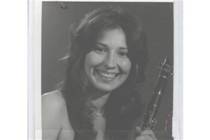
5 October 2007
|
Julie Anne Vaverka - In Memoriam
(b.
Sept 6, 1953, Enid, Oklahoma)
Manchester,
New Hampshire USA
[Obituary by Sue-Ellen Hershman-Tcherepnin and Andrew Wilson]
The one
thing that colleagues and friends will remember most about Julie Vaverka
is her voice, whether from the other end of the telephone line, or from
the bell of her clarinet. Julie never had to fear that she would not be
heard. She was a commanding presence, with a speaking voice that could
reach across the prairie expanses of her native
Oklahoma. One only had to hear the first words to know
that Julie was on the telephone, often with the welcome news that she was
offering orchestral employment to
New
England’s musicians. More importantly, however, was the voice of beauty,
grace, and harmony that she summoned from her clarinet during the hundreds
of classical concerts in which she performed throughout New England for
more than thirty years.
That voice was stilled in a
Manchester,
NH hospital on
October 5, 2007, after a long and valiant battle with metastatic
breast cancer.
Raised on the
family wheat farm in
Marshall,
Oklahoma, Ms. Vaverka took a different path from an early
age. She started learning piano at the age of 5, and towards the end of
elementary school, chose the clarinet. As a child, she often played duets
with her trumpet-playing dad (and sometimes trios when brother Jesse
joined in), learning traditional Czech polkas first-hand in the thriving
ethnic community of
Garfield and
Kingfisher
Counties. Her musicianship developed rapidly as her mom
drove her to
Enid each week to study with Dr. Max Tromblee,
clarinet instructor of the Phillips University Music Department. She later
enrolled at the prestigious
Interlochen
Arts
Academy, determined to become a professional
clarinetist. She then went to study with Steve Girko at
Oklahoma
University, at the
Eastman
School of Music under
Stanley Hasty, and later with
Boston Symphony principal clarinetist Harold Wright. At
age 19 she became the youngest member of the
Oklahoma City Symphony Orchestra.
After moving to the
Boston area in the 70’s, she established herself as an
indispensable, passionate free-lance artist and teacher. She soon became a
member of the New
Boston Wind Quintet, and in 1978, co-founded the Pro
Arte Chamber Orchestra cooperative. Julie was profoundly devoted to the
orchestra as principal clarinet, soloist, and concert organizer until her
death. She also performed regularly with the
Boston Symphony,
Boston Pops, the
Rhode Island Philharmonic, the
Boston Ballet Orchestra, and the
Springfield (MA) Symphony. She was a regular member of the
Monadnock Festival Orchestra and the
New Hampshire Symphony, serving simultaneously as clarinetist
and personnel manager for both organizations. Springfield Symphony
principal clarinetist Michael Sussman, her colleague of over 30 years,
described her this way: “Julie certainly studied with great teachers –
Wright, Hasty, Moyse - but when she first came to this area, she was
already a really excellent player. Of course she grew musically over the
years. But she was just a natural, great musician, and she loved her
colleagues.”
One of her career
highlights was playing by Mr. Wright’s side as interim second clarinet of
the
Boston Symphony for the two years prior to Mr. Wright’s
death, and for the two years following. At the BSO she also performed with
the BSO Chamber Players at Prelude Concerts at Symphony Hall, at the
Tanglewood Music Festival, and as a founding member of the
Boston Wind Octet with Harold Wright and now-retired
BSO oboist Alfred Genovese. Genovese recalls, ““Julie was so darn good – a
fantastic musician! She was plenty talented to be a regular member of the
BSO, and when we played together, she was just one of us. She was also an
amazing friend, and I loved her like a sister.”
Ms. Vaverka
recorded for both the
Boston Pops and the
Boston Symphony Orchestra during her time with the
orchestra. These recordings include Benjamin Britten's Young Person's
Guide to the Orchestra under Seiji Ozawa, Ravel's Rapsodie Espagnole under
Bernard Haitink, and the movie soundtrack for Schindler's List under John
Williams, for which she performed as principal clarinetist.
During rehearsals
Julie was famous for her infectious laugh and straight-from-the-hip
manner. Her deep love of animals was ever-present at rehearsals in the
form of a tiny, impeccably behaved dog lying on stage in a soft carrier
next to her clarinet case. Well-concealed, conductors never seemed to even
notice that a dog was there.
A devoted and beloved
teacher, Ms. Vaverka served on the faculties of
Phillips
Exeter
Academy, the Boston Conservatory of Music,
University of
Connecticut,
Boston
University, and
Dartmouth
College. She maintained lifelong connections with many
of her students, who were deeply touched by the continued love she devoted
to them long after their studies were completed. Rohan Smith, chairman of
the music department at Exeter, where Julie taught for over 20 years,
described her impact on the school: “The Academy simply came alive in
Julie’s presence. Over the years, letters arrived from
Exeter graduates who mentioned that she imparted not
just incredible skills, but her love of music and life.”
In 1997, Ms. Vaverka
decided to relocate to NH, where she was teaching and playing more and
more. Eva Gruesser, concertmaster of the NH Symphony, recalls that Julie
“was the heart and soul of the
New Hampshire Symphony, as well as the motor that kept it
going." After a long search, she bought some land atop
Mount
Delight, where she could relish the pace of country life
and yet manage frequent commutes to
Boston. She had a home built to her designs and
relished being surrounded by farmland again. Her yard soon grew into an
organic
Eden of horticultural wonders, from exotic, fragrant
flowers to European heirloom tomatoes and Crandall currants, all lovingly
tended until her final days.
Julie was also a talented
cook and wine connoisseur. Her passion for the culinary arts nearly drove
her to give up music as a career in order to pursue her equally compelling
dream to become a professional chef. She enrolled at the
Cambridge
School of Culinary Arts, and after completing her
degree, realized she simply could not tolerate the large musical hole in
her life. She returned to music, but shared her extraordinary culinary
gifts with others at every possible turn. Whether sublimely turning a
phrase of Schubert or delicately turning a Coq au vin, her life reflected
an enormous heart and consummate artistry.
Plans for a celebration of her
life will be announced at a later date. In lieu of flowers, donations may
be made to Pro Arte Chamber Orchestra,
107 Brighton Avenue, Suite #1,
Boston,
MA
02134. |
|
|
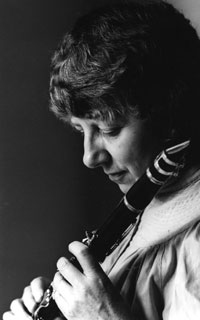
26 June,
2007
Thea King –
In Memoriam
London,
England
Last
Updated: 1:59am BST 02/07/2007
Thea King, who died on Tuesday aged 81, was the doyenne of English clarinettists;
a versatile and popular musician, her mellifluent tones were also well known to
viewers of children's television in 1970, thanks to her accompaniment in the
BBC's colour series of Andy Pandy.
Her playing produced a sound
that was hard to resist, leaving a warm glow lingering for hours afterwards like
the embers of a fire refusing to die away. Her enthusiasm bordered on the
infectious, and her ability to encourage others was inspirational. Everywhere
she played her technique was fluent and incisive, bringing a sparkle to the
occasion while still delivering a solid performance rooted in the long-standing
English clarinet tradition.
Thea King's recording of the Stanford and Finzi concertos on Hyperion
launched that popular label. It was her love of cows - which feature on most of
her album covers - that led to Ted Perry, Hyperion's founder, using works of art
rather than pictures of the musical performers on the sleeves of his discs
Her later coupling of
Mozart's Clarinet Concerto and Quintet, on which she played the basset horn,
went on to become the label's second best-selling release of all time, and her
discography - both for Hyperion and elsewhere - was once described as being "as
long as a basset clarinet".
Thea King was born at
Hitchin, Hertfordshire, on Boxing Day 1925. Her father was Henry King, MBE,
formerly manager of the family business, GW King Ltd, a paint and varnishing
company based at Rossendale, Lancashire. Her mother, Dorothea, was musical and
taught her daughter the piano as soon as she could read.
It was not until some years
later, when she was in her final year at Bedford High School, that Thea was
given a clarinet, so that she could participate in a new wind section in the
school orchestra.
She later recalled: "The
teacher who had been using it only had time to practise in the evenings, but it
gave her indigestion." Within a few months of taking up the instrument Thea was
playing for an approving Herbert Howells in a competition.
At the Royal College of
Music, to which she won a scholarship during the latter years of the war, Thea
King studied piano with Arthur Alexander - the clarinet was still her second
instrument. "In those days it helped if you played two instruments, however
poorly," she said.
In January 1953, five
years after graduating, she married her clarinet teacher, Frederick "Jack"
Thurston, a pupil of Charles Draper, and still regarded as one of the finest of
all 20th-century clarinettists.
"He taught me that it was
possible to play more beautifully and more convincingly than I had ever dreamed
of and that it must take incredible courage and idealism," she once said.
It was a devastating blow
for Thea Thurston when her husband died of lung cancer in December that year at
the age of 52, only 11 months after their marriage.

26 June 2007
Dr. Michael Sullivan - in Memoriam
(1964-2007)
Flagstaff, Arizona USA
Dr. Michael Sullivan, Professor of Clarinet at the Northern Arizona University
School of Music in Flagstaff, Arizona, passed away on June 26, 2007, due to
complications from bone cancer. Michael was convalescing from tumor surgery
with his family in Orlando, FL, when his condition accelerated beyond
treatment. His strong and supportive family was with him at death. He also
served as NAU's Coordinator for the Wind and Percusssion area, and in 2005,
Michael was selected as Teacher of the Year for the NAU School of Music. He
received his degrees from Florida State University (B.M.E., D.M.) and the
University of Michigan (M.M.). Upon receiving a grant from the German Academic
Exchange Service, he studied at the Staatliche Hochschule für Musik in Munich,
Germany, and as first prize winner of the Pro-Mozart Society of Atlanta Concerto
Competition, he was awarded a grant to study at the Hochschule für Musik und
Darstellende Kunst (Mozarteum) in Salzburg, Austria where he earned certificates
in clarinet and saxophone. Dr. Sullivan served on the faculties of the
University of Michigan at the Interlochen Center for the Arts and Pittsburgh
State University. He appeared as soloist with symphony orchestras throughout the
United States and presented numerous recitals in the U.S. and Europe, most
notably performing at the Salzburg Festival in 1993. Michael Sullivan served as
principal clarinetist with the Ernest Bloch Music Festival in Newport, Oregon
and the Flagstaff Symphony Summer Ensemble and served as principal clarinetist
with the Phoenix Mainly Mozart Festival, the Flagstaff Festival of the Arts
Orchestra and Arizona Opera's Wagner Festival Orchestra. He performed as guest
artist with the Music Academy of the West, the U.S. Army Field Band, and the
Sedona Chamber Music Festival. He frequently appeared as a recitalist,
adjudicator, and clinician with universities and high schools across the
country. His principal teachers included Frank Kowalsky, Fred Ormand, Gerd
Starke, and Alois Brandhofer. Michael was also proficient on piano, flute,
violin, and tin whistle, and performed on these instruments regularly with his
folk music ensemble, the Frayed Knots, where he enjoyed maintaining his Irish
heritage.
Denise A. Gainey, DMA
Associate Professor of Clarinet and Music Education
Coordinator of Graduate Studies in Music
The University of Alabama at Birmingham
(205) 975-0558
clarinet@uab.edu
"Practice and hope.....but never hope more than you practice."
Kalmen Opperman
19 June 2007
Efrain Guigui –
Former Conductor of the Vermont Symphony and Clarinetist - In Memoriam
Burlington, Vermont
USA
A former conductor of the Vermont Symphony Orchestra died Monday in Los Angeles
from complications of cancer. Efrain Guigui was 81.
· Guigui
led the VSO from 1974 to 1989, notably taking the orchestra on a tour of all of
Vermont's 251 towns to celebrate the 50th anniversary. During his tenure,
Guigui, a clarinetist, as awarded the Alice Ditson award from Columbia
University, which is considered to be the conductors' equivalent of the Pulitzer
Prize. In 1989 the Vermont Council on the Arts presented him with the Gov.'s
Award for Excellence in the Arts.
"Vermont gave him a lot," said Martin Guigui, his son. "Vermont gave him the
opportunity to find his voice as a conductor. He loved the people, he loved the
spirit for the arts in Vermont. He said that it was unequaled anywhere else he
had worked: the support for the arts, the spirit of the people he got to work
with, and the spirit of the audience."
Guigui was born in Panama and raised in Argentina. He moved to Middlebury in
1974 to lead the VSO. After leaving Vermont Guigui did guest conducting in
South America and started a youth orchestra in Mexico, his son said.
He was invited to conduct in many places, including the Julliard School in New
York.
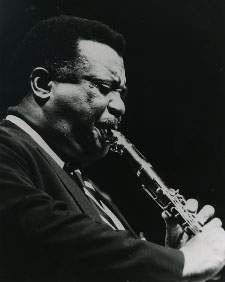
5 May 2007
Alvin Batiste, 74; veteran jazz clarinetist - In
Memoriam
By Adam Bernstein, Washington Post
May 7, 2007
New Orleans, Louisiana USA
Alvin Batiste, a widely respected jazz clarinetist, composer and educator
who played across the musical spectrum, from traditional to avant-garde
styles, and was a prolific figure on the jazz festival circuit, died Sunday at
his home in New Orleans after an apparent heart attack. He was 74.
He played Saturday at FestForAll, a celebration in Baton Rouge, La., and died
hours before he was scheduled to perform with pianist and singer Harry Connick
Jr. and saxophonist Branford Marsalis at the New Orleans Jazz & Heritage
Festival.
Batiste recorded sparingly but performed with saxophonists Ornette Coleman and
Cannonball Adderley, considered modern jazz greats, as well as musicians as
diverse as drummer Billy Cobham and pianist Dr. John. Never a household name
but always admired among musicians, Batiste received broader recognition in
the 1980s, touring and recording with Clarinet Summit, a quartet that included
John Carter, David Murray and Jimmy Hamilton.
Batiste was born Nov. 7, 1932, in New Orleans, where his father, a railroad
worker, played traditional jazz clarinet on the side. Outside home, Batiste
grew immersed in the city's music offerings.
"I remember following a parade when I was 3 years old," he told a Baton Rouge
reporter last year. "It was Easter Sunday. I had on a little white suit and,
all over New Orleans, the people fed me. When I got home, after they expressed
the happiness for me being there, then they almost killed me."
Batiste received extensive musical training through the school system and, as
a college student, was a guest soloist with the New Orleans Philharmonic,
playing a Mozart clarinet concerto.
He was a 1955 music education graduate of Southern University and later earned
a master's degree in clarinet performance and composition at Louisiana State
University.
Batiste was increasingly influenced by bebop jazz pioneers such as saxophonist
Charlie Parker. In 1956, he helped start the American Jazz Quintet in New
Orleans with drummer Ed Blackwell, pianist Ellis Marsalis, saxophonist Nat
Perrilliat and bass player Chuck Badie.
Batiste considered the American Jazz Quintet an experiment in a modern
chamber-jazz sound, and it resulted in an early album, "In the Beginning."
Competent on piano and saxophone, Batiste was called on for his
multi-instrumental skills while touring with rhythm-and-blues artists such as
Ray Charles, Guitar Slim and Little Willie John.
He also was a studio musician for the AFO ("all for one") label in New Orleans
and toured regionally with his band, the Jazztronauts. That group included
many of his music students at Southern University, where he helped create the
jazz studies program in the late 1960s.
As an educator, Batiste influenced several generations of performers,
including Branford Marsalis (son of Ellis, brother of Wynton) and pianist
Henry Butler. Though retired from Southern University, he continued to teach
at the New Orleans Center for Creative Arts, a conservatory for young adults.
His first major-label release was 1993's "Late" for Columbia Records, which
included several of his compositions and a trio led by pianist Kenny Barron.
This year, Branford Marsalis produced "Marsalis Music Honors Alvin Batiste,"
which showcased Batiste's compositions.
Batiste is survived by his wife of 53 years, Edith Chatters Batiste of New
Orleans and Baton Rouge; three children, Alvin Batiste Jr. of Plaquemine, La.,
Marcia Wilson and pianist Maynard Batiste, both of Baton Rouge; a sister; and
12 grandchildren.
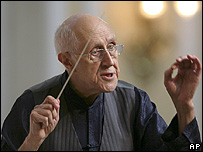
27 April 2007
Russian cellist and Conductor Mstislav Rostropovich - In Memoriam
Moscow, Russia
Musical legacy of cellist legend
Rostropovich celebrated his 80th birthday in March
The celebrated Russian cellist and conductor
Mstislav Rostropovich has died at the age of 80.
James Jolly, editor-in-chief of Gramophone magazine, looks back at his musical
legacy.
With the death of Mstislav Rostropovich, the musical world has lost not just one
of its greatest interpreters but also one of the greatest muses of the 20th
Century.
As a cellist, he was responsible for the creation of hundreds of new works, many
from some of the greatest composers of the day.
Prokofiev, Shostakovich, Britten, Lutoslawski and Penderecki all wrote concertos
or concertante works for him, and hundreds of lesser composers were the
beneficiaries of his boundless enthusiasm for new music.
'Unique human spirit'
Rostropovich was a real musical polymath. Not only was he a cellist without
equal but he was also a fine conductor.
He was music director of Washington's National Symphony Orchestra (NSO) from
1977 to 1994 and he enjoyed a long and fruitful relationship with the London
Symphony Orchestra (LSO) - those two partnerships are well represented on disc.
Rostropovich had an unconventional conducting technique
He was also an accomplished pianist, often playing for his wife, the soprano
Galina Vishnevskaya.
But above all he was a consummate communicator in everything he did - his
idiosyncratic English, his opening plea to anyone he met to 'Call me Slava', his
passionate, tactile grasp of life all combined to make him a colossus and a
unique human spirit.
Of all his musical friendships, it was that with the composer Dmitri
Shostakovich that bore the most fruit.
Not only did Shostakovich write both of his cello concertos for Slava, but also
the cello part of his setting of Alexander Blok poems.
Proms performance
Rostropovich also played as an orchestral cellist in the 1962 revival of
Shostakovich's opera Lady Macbeth of the Mtsensk District, renamed Katerina
Ismailova.
He later recorded the work for EMI with Vishnevskaya in the title role.
As a cellist he had a large sound - a beautiful musical expression of his
generous personality.
He often worked with legendary composer Dmitri Shostakovich
His recording of the Bach cello suites, made in 1995, is pure Rostropovich -
heart-on-sleeve, buoyant, songful and above all, so clearly a genuine response
to the composer's message.
It became a hugely successful release, selling about 250,000 copies to date.
Another non-Russian work with which he was closely associated was the Dvorak
Cello Concerto, which he recorded many times.
His Deutsche Grammophon disc with Herbert von Karajan is probably the
best-selling of his many versions, but by far the most charged is a live
recording of a Proms performance given the day that Soviet tanks entered Prague
on 21 August, 1968.
Nicholas Kenyon, the current director of the Proms, recalls hearing the concert
on the radio and noted the protests within the Albert Hall.
Rostropovich was a mentor to violinist Maxim Vengerov
'But the irony was that Slava, as the most committed advocate of freedom, was on
their side, playing a great Czech piece. At the end of the concerto, as an
encore, he played a solo Bach Sarabande in tears and dedicated it, sotto voce,
to the Czech people,' said Kenyon.
Rostropovich enjoyed musical partnerships with many of the world's greatest
artists. He performed regularly with pianists like Sviatoslav Richter, Emil
Gilels, Vladimir Horowitz, Rudolf Serkin and Martha Argerich.
Not only did Benjamin Britten write a number of works for Rostropovich - the
cello symphony and cello suites among them - but they performed regularly as a
piano and cello duo.
Thankfully, there are recordings of this inspiring partnership - not least of
which are glorious accounts of cello sonatas by Debussy and Frank Bridge, works
by Schubert and Schumann, as well as pieces by Britten himself.
Emotional charge
From a younger generation he championed the Korean cellist Han-Na Chang and is
held to be one of violinist Maxim Vengerov's real musical mentors - they
recorded works by Prokofiev and Shostakovich, Shchedrin and Beethoven.
He was as generous with his time and advice as he could be with a schedule that
combined so many musical disciplines.
And like his friend Leonard Bernstein, Rostropovich was a musician who blossomed
in front of an audience.
Some of his tempi could be broad but there was no denying the emotional charge
that lay behind his interpretative decisions.
His somewhat unconventional technique as a conductor was never an impediment to
his extraordinary ability to speak directly to every member of the audience.
And as a cellist: well, he was simply one of the greatest.
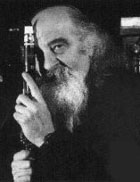
28 March 2007
Tony Scott - In Memoriam
85; Jazz Clarinetist Explored Eclectic Mix
of Music
Rome, Italy
Washington Post Staff Writer
Sunday, April 1, 2007; Page C06
Tony Scott, 85, a jazz musician who
helped expand the musical limits of the clarinet and who was
an early proponent of what is now called world music, died
March 28 at his home in Rome, where he had lived for more
than 30 years. He had prostate cancer.
A musician of vast and
eclectic range, Mr. Scott found fame in the 1940s as one of
the first clarinetists to master the difficult new jazz
idiom of bebop, with its tricky chords and acrobatic runs.
He led his own groups as a clarinetist, played in the
saxophone sections of bands led by Duke Ellington, Tommy
Dorsey and Buddy Rich and also performed as a pianist. In
the mid-1950s, when he was music director for singer Harry
Belafonte, he wrote the arrangement for "Banana Boat Song
(Day-O)," one of Belafonte's biggest hits.
Mr. Scott recorded with
such renowned musicians and singers as Dizzy Gillespie,
Thelonious Monk, Bill Evans, Sarah Vaughan and Billie
Holiday, yet he spoke fondly of times when he'd walk down
streets in Bulgaria or Indonesia, piping away on his
clarinet. He spent several years in Asia and Africa in the
1950s and '60s and made albums reflecting his interest in
the music of other cultures.
"I was searching for
something new, emotionally and spiritually," he said in a
1966 interview. "The jazz world here had turned cold for me
-- cool jazz, cool people. It was without passion. I found
the warmth I sought in Japan."
He had an outgoing
personality that made him popular with other musicians. He
wrote songs for Holiday, with whom he recorded on clarinet
and piano, and also composed music for short films featuring
stripper Lili St. Cyr.
At his peak in the 1940s
and '50s, Mr. Scott was considered the most advanced
clarinetist of his generation, rivaled only by Buddy
DeFranco. In 1953, critic Nat Hentoff wrote in Down Beat
magazine: "No other modern clarinetist has the fire, the
drive, and the beat Tony generates."
"Mr. Scott has stretched
the jazz range of his instrument farther than any of his
contemporaries," John S. Wilson wrote in the New York Times
in 1958. "He is the most exciting jazz musician playing
today."
Mr. Scott, whose given
name was Anthony Joseph Sciacca, was born June 17, 1921, in
Morristown, N.J., the son of Sicilian immigrants. He began
playing a metal clarinet at age 12, formed his first band at
14, quickly mastered the piano and was playing in Harlem
jazz sessions by the time he was 18.
He studied for three
years at the Juilliard School, performing Ellington's
"Sophisticated Lady" on piano as his audition piece. He
played in Army bands during World War II and spent nights in
New York jazz clubs.
In 1943, he first heard
saxophonist Charlie Parker, one of the progenitors of the
new bebop style, and was determined to bring Parker's
musical advances to the clarinet. They often performed
together, and Mr. Scott would later call Parker the greatest
man -- not just the greatest musician -- of the century.
At a concert in
Yugoslavia in 1957, two years after Parker's death, Mr.
Scott improvised "Blues for Charlie Parker," which became
his best-known composition.
"It was a
spur-of-the-moment thing," he said. "The audience gave me a
five-minute standing ovation. Musically, it was the high
point of my life."
In 1970, he settled in
Rome and formed a five-year musical association with Romano
Mussolini, an acclaimed jazz pianist who was the son of
Italy's executed fascist leader. Mr. Scott experimented
broadly with musical styles in the 1970s and '80s before
returning to more traditional jazz late in his career.
"Without experimenters,
jazz would die a lingering death," he said on his Web site.
"I believe in being receptive to all music. . . . If you
stop learning, you might as well throw your horn away."
Cultivating an air of
eccentricity, he grew a chest-length white beard and
sometimes took apart his clarinet onstage, pretending to use
it as a telephone. Nonetheless, his playing remained strong,
and he continued to perform into his 80s.
In addition to his
performing career, Mr. Scott had a large collection of
photographs of jazz musicians and made jazz-influenced
paintings.
|
|

|
|
Ken Domer
|
|

|
|
Christmas visit with former Army Band members Richard Harmon, Charles Boyer and Wade Lineberger
|
|

|
|
Domer soloist with Henry Cuesta and Band combo
|
|
|
14 February 2007
In Memoriam - Kenneth Domer, Sergeant Major Retired
Melbourne, Florida, USA
Kenneth Domer,
a Major icon and soloist in The United States Army Band (Pershing's Own) in
Washington DC from 1961 - 1990, died in Florida on this date. He is
remembered as an icon at this Premiere Band as a jazz soloist frequently on
tours, major events such as the annual 'Spirit of America' , and as an
administrating Woodwind Group Leader charged with daily section responsibilities
addressing all taskings in running the musical requirements in the section.
In addition to this function, he performed clarinet and alto clarinet in the
Concert Band and also performed in Ceremonial functions on occasion as needed.
As a soloist, he has performed dixieland often and performed with luminaries
such as Henry Cuesta, a guest soloist who performed with Lawrence Welk in the
1980's. After retirement in 1990, SGM Domer moved to Florida and has kept
open ties with the Band and colleagues.
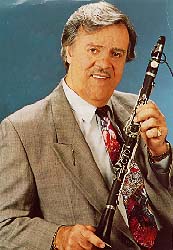
23
February 2007
In Memoriam -
Lazarus Harisjadis - 7 generations of Greek Epirotika Music
Delvanaki, (Epirus) Greece
Sadly, Lazaros passed away February 23, 2007
after a long illness. The memory of his divine soul will always be with us as
his love for life will always serve to be an inspiration to all who knew him.
His strength of character and love for the arts has touched everyone who crossed
his path. His soul is divine and at peace and guiding us, as he did in life. I
will love you eternally
Lazaros Harisiadis, born in Delvanaki, (Epirus) Greece is a respected musician,
composer - acknowledged as a virtuoso on the clarinet. He also performs on a
range of folk instruments from Greece such as laouto, (lute), deffy (tambourine)
and is a respected vocalist of the traditional music of Epirus, Greece.
Lazaros comes from a family of musicians going back seven generations. He began
studying music with his father, a well-known musician at the time, and has since
gone on to perform with well known artists in Greece and the United States.
He came to the United States as a musician with the Panallion Group of dancers
and musicians in 1961 and has since then been residing in New York City
performing at weddings, festivals and cultural events throughout United States
and Canada sponsored by the National Endowment for the Arts and Ethnic Folk Arts
Center. Lazaros also has many tape and record recordings to his credit
accompanying the Halkias Family Orchestra.
EPIROTIKA MUSIC OF GREECE
Epiros, is just south of Albania, a very rugged mountainous area with limited
resources. The music of Epiros reflects the harsh land which has forced its
people to travel to distant lands in search for livelihood.
The music of Epiros is highly developed in the instrumental ensemble tradition.
These ensembles consist of clarinet, violin, laouto (lute) and defi (hand
drum).The clarinet in the main vehicle of expression. The clarinetists are well
known for their excellence of their profound emotional expression.
The most beautiful examples of Epirotika music are in the free style melodies
such as Miryioloi and Skaros. Here the lower tones of the clarinet are expressed
reflecting a range of emotion from thwarted love affair to the pain of death or
living in a foreign land.Mirioloi literally means to lament and and intensely
emotional mood is created in this type of music.
My personal experience with Epirotika music is that it is very compatible to the
Hindustani system of ragas. Whereas a particular range of notes are played to
reflect the emotional range of human experience. I was drawn to it because of
its emotional intensity. A raga is similar to the Miryioloi of Epirus. It gives
a melodic base with rules governing its elaboration and yet allowing for
improvisation. The raga decides the mood of a situation and governs its
emotional impact.
The rhythm or tal on the other hand, binds the music together. It is a time
cycle that remains fixed throughout a particular rendering. Similarly, the
rhythm repeats itself in cyclic regularity, offering amazing dimension for
improvisation between beats. To listen to the interplay of rhythm with musical
phrases is a fascinating experience. The division of time into minute pluses,
the crisscross patterns, the regular and off-beat emphasis of time, the running
together of two contrary cycles meeting creatively at a point, offer a
regularity that stimulates the emotions and an excitement that heightens mood.
Notes by Najma Ayashah
|
|

|
|
Ted Lane and Menotti in 1976
|
|

|
|
Gian Carlo Menotti
|
|
|
1 February 2007
In Memoriam - Gian Carlo Menotti
Monaco, Morocco
A great figure passed on
Gian Carlo Menotti
The enclosed photo was taken on his 65th Birthday on July 7th in Spoleto, Italy
where he directed his festival.
Mr. Menotti allowed thousands of young musicians to take part in world class
performances. He founded three of the best music festivals on our planet:
Spoleto Italy, Charleston (USA) and one in Australia. He opened musical doors to
many and brought joy to millions.
When I performed his 1951 Opera "Amahl and the Night Visitors" in High School in
1971 under the direction of Charles Emmons, little did I know he would make a
major impact on my career. It was only three years later that he appointed me
Principal Clarinet of the Spoleto Festival.
I am grateful for all the many wonderful musical opportunities he made
possible. The many friendships that are alive to this day.
He will be in my heart for ever.
Ted Lane
http://www.nytimes.com/2007/02/02/arts/music/02menotti.html
Copyright ©
1999 WKA-Clarinet.org. All rights reserved.
Revised: December 19, 2010









 Orchestra,
the Boston Pops Orchestra, and the Detroit Symphony. He was a fine
representative of the United States Army and of the music community.
People close to him knew him for his old-fashioned, Middle American
sensibilities, his passion for excellence in music, his cheerful
pursuit of golf, and his appreciation of a good joke. His Soldiers
knew him as an honest, even-handed commander.
Orchestra,
the Boston Pops Orchestra, and the Detroit Symphony. He was a fine
representative of the United States Army and of the music community.
People close to him knew him for his old-fashioned, Middle American
sensibilities, his passion for excellence in music, his cheerful
pursuit of golf, and his appreciation of a good joke. His Soldiers
knew him as an honest, even-handed commander.





 Legendary saxophonist and clarinetist Alfred J. Gallodoro, featured
soloist with the Paul Whiteman Orchestra from 1936 to 1940, passed
away October 4th at the age of 95. During a professional career
spanning more than eight decades, Gallodoro worked in virtually
every musical environment, from vaudeville houses, speakeasies, and
night clubs to symphonies, Carnegie Hall, and international jazz
festivals. He claimed to be one of the world's longest continually
active performing musicians. He was referred to by Jimmy Dorsey as
". . . the greatest saxophone player that ever lived," and received
similar plaudits from the likes of Paquito D'Rivera, Benny Golson,
Buddy DeFranco and Eddie Daniels.
Legendary saxophonist and clarinetist Alfred J. Gallodoro, featured
soloist with the Paul Whiteman Orchestra from 1936 to 1940, passed
away October 4th at the age of 95. During a professional career
spanning more than eight decades, Gallodoro worked in virtually
every musical environment, from vaudeville houses, speakeasies, and
night clubs to symphonies, Carnegie Hall, and international jazz
festivals. He claimed to be one of the world's longest continually
active performing musicians. He was referred to by Jimmy Dorsey as
". . . the greatest saxophone player that ever lived," and received
similar plaudits from the likes of Paquito D'Rivera, Benny Golson,
Buddy DeFranco and Eddie Daniels.

















